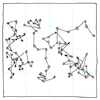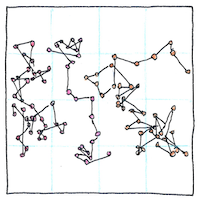Robert Brown, Ludwig Boltzmann, Albert Einstein, Jean Baptiste Perrin
physics

|
Brownian motion
Scottish botanist Robert Brown, examining starch and lipid organelles ejected from grains of pollen in water, observed a continuous jittery motion. The issue was whether energy or atoms were pushing the particles around. In spite of the work of John Dalton, many physicists didn’t believe in atoms and molecules. German physicist Ludwig Boltzmann, who developed the kinetic theory of gases, claimed that what we know as heat was simply atoms and molecules moving rapidly. Albert Einstein modeled the collective motions of particles, focusing first on their diffusion over time, then on the measurable quantities, which let him predict the sizes and number of atoms in a gas. French physicist Jean Baptiste Perrin experimented with colloidal suspensions to verify Einstein’s predictions, thus settling the century-long dispute about Dalton’s atomic theory.
Particulate energy
Shake atoms up and they get hot. Excited, they expand; contract, they emit photons. They can hold only so much, take only so much pressure, and do only so much work until they come to rest. Even the vacuum of empty space is believed to have energy, vacuum fluxuations, vibrating fields, or virtual particle pairs, and thus have mass, which is quantized, but never rests.
Solids
My fingers on your arm, a solid feeling a solid, or softness, do not betray the fact that they, or your arm, that is, their atoms, are widely spaced like distant planets around a sun.



One foundation of Einstein’s formulas for the size and number of atoms in a gas is Avogadro’s Law, which states that the masses of the same volume of different gases at the same temperature and pressure are proportional to the weights of the atoms or molecules in the gases. The number of particles in one mole of a substance (a big number) is known as the Avogadro constant, and a mole of a substance is this number of particles of the substance.
Eventually, all these matters seem circular.
See also in The book of science:
Readings in wikipedia: